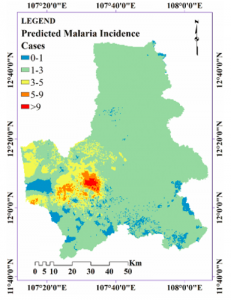Malaria is one of the most common parasitic diseases found in all parts of the world. It is considered to be one of the most dangerous endemics in 91 countries, infecting 212 million people and killing more than 429,000 people (Hoang et al., 2018). It is transferred through mosquito bites and occasionally from mother to fetus, blood transfusion, and the sharing of needles (Government of Canada, 2016). This disease is most prominent in tropical and subtropical regions where it encourages the growth of Anopheles mosquitos and malaria parasites within the mosquitos (CDC, 2018). Hoang et al. conducted a study in Vietnam, with 74% of the population having malaria risk, specifically in the DakNong province which is one of the most vulnerable areas to malaria. Their goal was to look for a new method to analyze factors that affect the outbreak of malaria. The new method consisted of a Locally-Compensated Ridge Geographically Weighted Regression (LCR-GWR) which accounts for the location dependence and the natural and social-economic relationships of malaria hotspots.
The LCR GWR was able to explain 50% of the malaria cases compared to GWR (which only explained 23% of the malaria cases) and OLS (which only explained 6% of the malaria cases). The models displayed a higher amount of malaria occurrences in the low terrain, near the border of Binh Duong and Cambodia. Hoang et al. found that this method is useful when accounting for several factors that vary among different regions such as land use, normalized difference vegetation index (NDVI), distance to residence, elevation, and distance to road that are highly associated with malaria risks. The results are further used to help measure malaria cases in the context of climate change and the impact on people’s livelihoods. Hoang et al. add that future studies would need accurate statistical and large enough sample size data. They claim that LCR GWR can be applied across the world as it accounts for the variation of local, physical, and social conditions.


Learning Significance